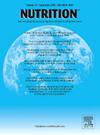相位角和身体组成之间的关系:预测脂肪量和骨骼肌量的新方程
IF 3.2
3区 医学
Q2 NUTRITION & DIETETICS
引用次数: 0
摘要
目的以相位角(PhA)为生物电参数,以DXA为参考方法,建立估算异种高加索人群脂肪质量(FM)和骨骼肌质量(SMM)的回归方程。我们还旨在交叉验证新方程,并将其与制造商的方程进行比较。方法将212例20 ~ 65岁健康白种人随机分为发展组(n = 141)和验证组(n = 71)。使用50 kHz脚对手相敏身体成分分析仪获得生物电参数。通过多元正回归分析,建立了新的FM百分比(FM%)和SMM百分比(SMM%)方程。通过平均差、决定系数、估计的标准误差(SEE)、一致性相关系数(CCC)和Bland-Altman图来评估DXA与不同方程之间的一致性。结果所提出的方程解释了dxa导出的FM%的89.2%方差和dxa导出的SMM%的91.8%方差,具有较低的随机误差(SEE = 分别为3.04%和1.92%)和很强的一致性(CCC = 分别为0.93和0.94)。此外,他们没有固定的偏见和相对较低的个体变异性。然而,制造商的方程描述了较低的方差百分比,具有较高的随机误差,FM%和SMM%的固定偏差为-5.77%和4.91%,以及较高的个体变异性。结论以PhA为生物电参数的回归方程能准确预测异种高加索人群中dxa推导的FM%和SMM%,是比制造商方程更好的选择。本文章由计算机程序翻译,如有差异,请以英文原文为准。
Association between phase angle and body composition: new equations to predict fat mass and skeletal muscle mass
Objective
The aim of this cross-sectional study was to develop new regression equations for estimating fat mass (FM) and skeletal muscle mass (SMM) in a heterogeneous Caucasian population, using the phase angle (PhA) as a bioelectrical parameter and DXA as the reference method. We also aimed to cross-validate the new equations, and to compare them with the manufacturers’ equations.
Methods
The 212 healthy Caucasian participants aged 20–65 years were randomly distributed into two groups: development group (n = 141) and validation group (n = 71). Bioelectrical parameters were obtained with a 50 kHz foot-to-hand phase-sensitive body composition analyzer. The new FM percentage (FM%) and SMM percentage (SMM%) equations were developed by performing multiple forward regression analyses. Agreement between DXA and the different equations was assessed by mean differences, coefficient of determination, standard error of the estimate (SEE), concordance correlation coefficient (CCC), and Bland–Altman plots.
Results
The proposed equations explained 89.2% of the variance in the DXA-derived FM% and 91.8% in the DXA-derived SMM%, with low random errors (SEE = 3.04% and 1.92%, respectively), and a very strong agreement (CCC = 0.93 and 0.94, respectively). In addition, they demonstrated no fixed bias and a relatively low individual variability. However, the manufacturer's equations described a lower percentage of the variance, with higher random errors, obtained fixed bias of -5.77% for FM% and 4.91% for SMM%, as well as higher individual variability.
Conclusions
The new regression equations, which include the PhA as a bioelectrical parameter, can accurately predict DXA-derived FM% and SMM% in a heterogeneous Caucasian population, and are better options than the manufacturer's equations.
求助全文
通过发布文献求助,成功后即可免费获取论文全文。
去求助
来源期刊

Nutrition
医学-营养学
CiteScore
7.80
自引率
2.30%
发文量
300
审稿时长
60 days
期刊介绍:
Nutrition has an open access mirror journal Nutrition: X, sharing the same aims and scope, editorial team, submission system and rigorous peer review.
Founded by Michael M. Meguid in the early 1980''s, Nutrition presents advances in nutrition research and science, informs its readers on new and advancing technologies and data in clinical nutrition practice, encourages the application of outcomes research and meta-analyses to problems in patient-related nutrition; and seeks to help clarify and set the research, policy and practice agenda for nutrition science to enhance human well-being in the years ahead.
 求助内容:
求助内容: 应助结果提醒方式:
应助结果提醒方式:


